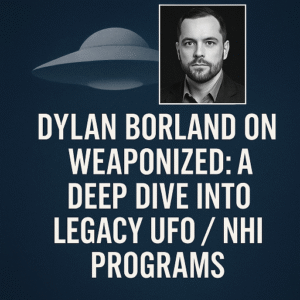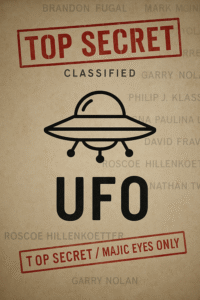In September and October 2025, Weaponized with Jeremy Corbell & George Knapp released a two-part interview with Dylan Borland: “The Reluctant UFO Whistleblower – Dylan Borland Tells All (Part 1)” (≈ 51 min) and “Dylan Borland Unloads – The Truth About Legacy UFO Programs (Part 2)” (≈ 1 h 38 min).
Borland is introduced as a former U.S. Air Force and defence-contractor insider with high-level clearances who became entangled in covert programs tied to unidentified anomalous phenomena (UAP) and non-human intelligence (NHI). He presents himself as a reluctant participant now speaking out because he believes secrecy has gone too far. Across both episodes he describes coercion, compartmentalisation, possible shoot-down orders, and systematic evasion of oversight.
Part 1 – Origins, Recruitment & Silent Entrapment
Background & Entry Path
Borland recounts a career trajectory from early FBI ambitions to the U.S. Air Force, later moving into intelligence-linked defence work (source). Although nominally military, he claims his assignments were steered by intelligence agencies operating beyond normal command channels (source). He says his duties increasingly concerned the management of anomalous phenomena rather than conventional defence work.
Security Clearance Leverage & Coercion
According to Borland, security clearances were weaponised to enforce silence (source). Refusal to cooperate, he says, meant career destruction, financial pressure, or worse. He describes an environment of extreme compartmentalisation – each person knowing only a fragment of the bigger picture – engineered to ensure plausible deniability (source). Threats and intimidation, he claims, became daily realities (source).
Observations of Anomalous Craft
Borland says he either witnessed or was briefed on unconventional craft that required “containment,” implying operational rather than merely observational encounters (source). He withholds technical specifics, citing classification, but insists such events were genuine.
Whistleblower Risks & Motivations
He frames disclosure as ethically necessary despite potential retaliation (source). Labelled by Corbell and Knapp as the “reluctant whistleblower,” Borland portrays himself as acting from conscience rather than self-promotion (source).
Part 2 – Legacy Programs, Shoot-Down Protocols & Insider Control
Part 2 expands into the heart of Borland’s allegations about hidden “legacy” UFO/NHI programs (source). He claims these operations exist entirely outside authorised oversight, buried under off-book budgets and mislabelled research lines.
Programs Hidden from Congress & Off-Book Funding
Borland says these secret efforts are designed to be invisible – even to senior defence officials (source). He describes disguised budget lines and phantom accounts that make auditing impossible (source). Even congressional hearings on UAPs, he argues, only touch the surface (source).
Shoot-Down Orders & “Flying Propane Tanks”
Borland alleges that active plans exist to shoot down certain UAPs. He characterises some craft as resembling “flying propane tanks” – spherical, pressurised, not aerodynamic (source). These objects, he says, are sometimes treated as hostile incursions (source), though no physical evidence has been released (source).
Insider Control Mechanisms
He outlines how insiders are controlled through surveillance, threats, and financial manipulation (source). Borland cites:
-
Constant monitoring of communications.
-
Family threats and career sabotage to enforce obedience.
-
Economic blackmail through withheld pay or credit manipulation.
-
Implied violence for potential leakers.
He claims many colleagues live under chronic psychological strain (source).
Colleague Interaction & Shared Burden
Borland says he met others who worked in similar compartments; many wanted to leave but were trapped (source). He describes mutual guilt and fear as constant companions.
Oversight Evasion & Structural Obfuscation
He contends that formal oversight mechanisms are bypassed via “parallel structures” – duplicate reporting lines masking true objectives (source). Even congressional briefings, he argues, are decoys shielding deeper layers (source).
Borland’s Goal & Call for Accountability
He insists his motive is institutional reform, not fame (source). Borland concludes that only transparency and lawful oversight can end the cycle of coercion (source).
Analysis & Assessment
Borland’s testimony is dramatic, rich in insider vernacular, and consistent with known secrecy tactics – but remains largely unverified.
Strengths & Credibility Factors
His account aligns with known compartmentalisation practices and evokes genuine insider detail. Themes of clearance leverage, intimidation, and financial pressure mirror historical intelligence-community behaviour (source). Narratively, it hangs together.
Weaknesses & Gaps
Publicly available material provides no declassified documents, imagery, or corroborating witnesses (source). Ambiguous phrasing such as “propane tanks” leaves interpretation open. Without physical or documentary evidence, claims of shoot-down orders or total oversight evasion remain speculative.
Questions for Follow-Up
– Are there traceable contract codes or budget anomalies matching Borland’s “off-book” description?
– Can independent FOIA or inspector-general records confirm the alleged parallel structures?
– Do other whistleblowers (e.g. David Grusch) corroborate Borland’s specific timeline or terminology?
Conclusion
The Weaponized interviews – Part 1 and Part 2 – stand as one of the more detailed recent whistleblower testimonies in the UAP conversation. Whether future investigators can substantiate Borland’s assertions about legacy programs, coercive control, and NHI engagement will decide whether his story becomes revelation or modern folklore.

